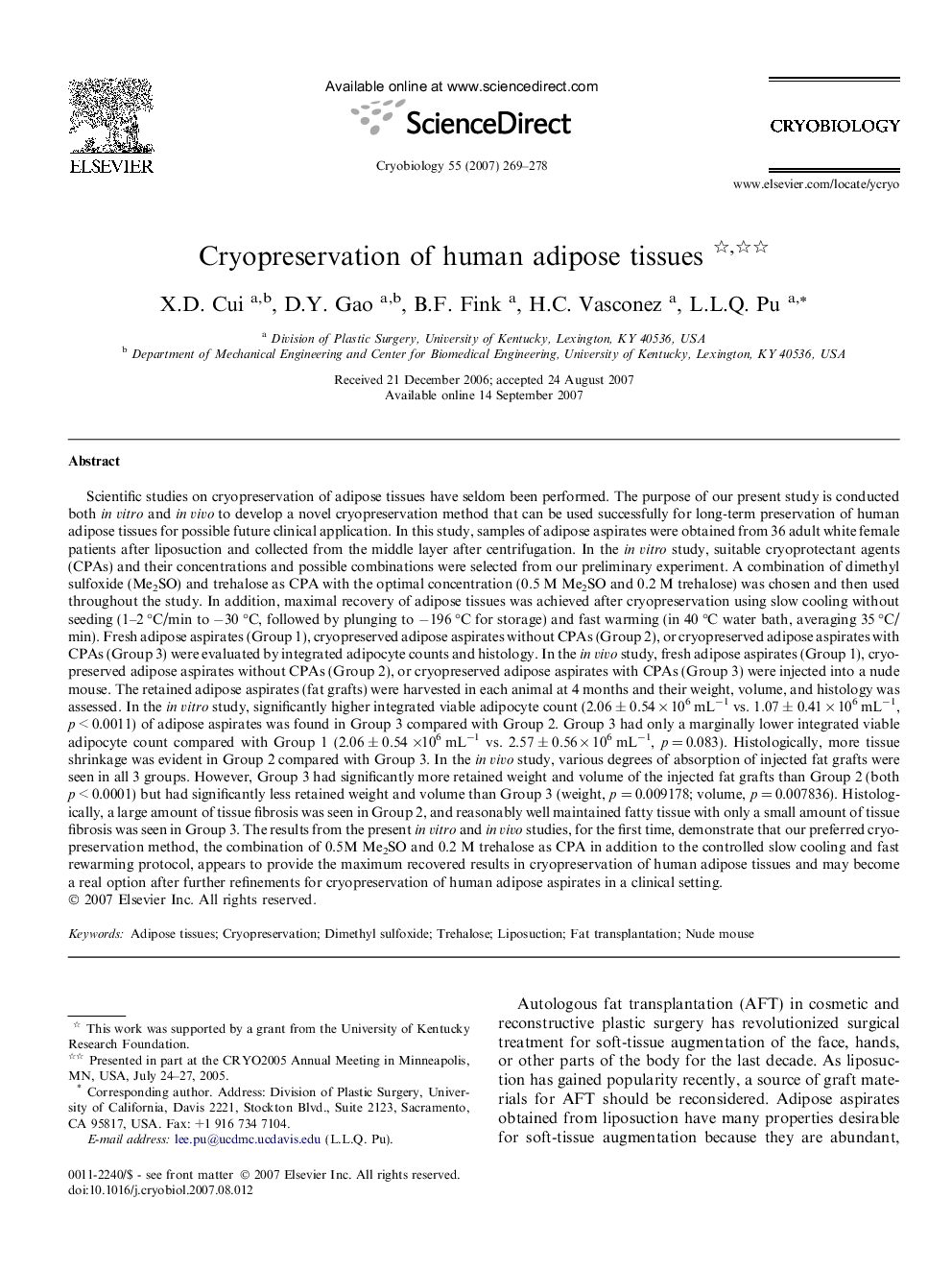| کد مقاله | کد نشریه | سال انتشار | مقاله انگلیسی | نسخه تمام متن |
|---|---|---|---|---|
| 2169333 | 1092937 | 2007 | 10 صفحه PDF | دانلود رایگان |

Scientific studies on cryopreservation of adipose tissues have seldom been performed. The purpose of our present study is conducted both in vitro and in vivo to develop a novel cryopreservation method that can be used successfully for long-term preservation of human adipose tissues for possible future clinical application. In this study, samples of adipose aspirates were obtained from 36 adult white female patients after liposuction and collected from the middle layer after centrifugation. In the in vitro study, suitable cryoprotectant agents (CPAs) and their concentrations and possible combinations were selected from our preliminary experiment. A combination of dimethyl sulfoxide (Me2SO) and trehalose as CPA with the optimal concentration (0.5 M Me2SO and 0.2 M trehalose) was chosen and then used throughout the study. In addition, maximal recovery of adipose tissues was achieved after cryopreservation using slow cooling without seeding (1–2 °C/min to −30 °C, followed by plunging to −196 °C for storage) and fast warming (in 40 °C water bath, averaging 35 °C/min). Fresh adipose aspirates (Group 1), cryopreserved adipose aspirates without CPAs (Group 2), or cryopreserved adipose aspirates with CPAs (Group 3) were evaluated by integrated adipocyte counts and histology. In the in vivo study, fresh adipose aspirates (Group 1), cryopreserved adipose aspirates without CPAs (Group 2), or cryopreserved adipose aspirates with CPAs (Group 3) were injected into a nude mouse. The retained adipose aspirates (fat grafts) were harvested in each animal at 4 months and their weight, volume, and histology was assessed. In the in vitro study, significantly higher integrated viable adipocyte count (2.06 ± 0.54 × 106 mL−1 vs. 1.07 ± 0.41 × 106 mL−1, p < 0.0011) of adipose aspirates was found in Group 3 compared with Group 2. Group 3 had only a marginally lower integrated viable adipocyte count compared with Group 1 (2.06 ± 0.54 ×106 mL−1 vs. 2.57 ± 0.56 × 106 mL−1, p = 0.083). Histologically, more tissue shrinkage was evident in Group 2 compared with Group 3. In the in vivo study, various degrees of absorption of injected fat grafts were seen in all 3 groups. However, Group 3 had significantly more retained weight and volume of the injected fat grafts than Group 2 (both p < 0.0001) but had significantly less retained weight and volume than Group 3 (weight, p = 0.009178; volume, p = 0.007836). Histologically, a large amount of tissue fibrosis was seen in Group 2, and reasonably well maintained fatty tissue with only a small amount of tissue fibrosis was seen in Group 3. The results from the present in vitro and in vivo studies, for the first time, demonstrate that our preferred cryopreservation method, the combination of 0.5M Me2SO and 0.2 M trehalose as CPA in addition to the controlled slow cooling and fast rewarming protocol, appears to provide the maximum recovered results in cryopreservation of human adipose tissues and may become a real option after further refinements for cryopreservation of human adipose aspirates in a clinical setting.
Journal: Cryobiology - Volume 55, Issue 3, December 2007, Pages 269–278